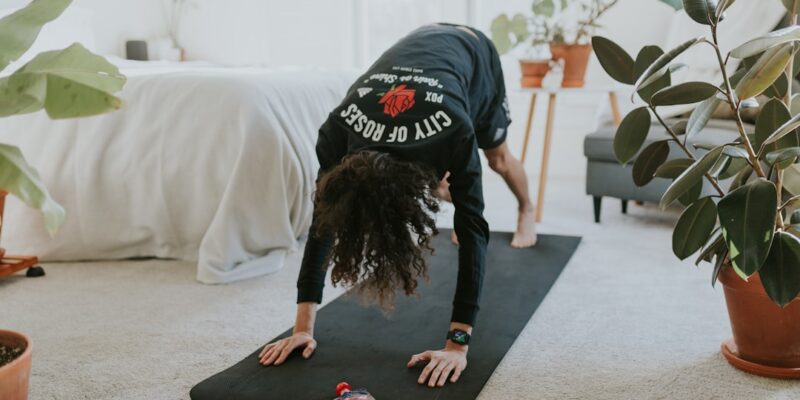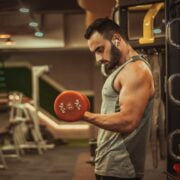
5 Effective Home Workouts to Stay Fit and Healthy!
Regular exercise is essential for maintaining overall health and well-being. It has numerous benefits, including weight management, improved cardiovascular health, increased muscle strength and endurance, enhanced flexibility and balance, and reduced stress levels. While many people prefer going to the gym or attending fitness classes, home workouts offer a convenient and accessible alternative. With the right equipment and knowledge, you can achieve your fitness goals from the comfort of your own home.
Key Takeaways
- Home workouts are important for fitness and health.
- Essential equipment for effective home workouts includes resistance bands, dumbbells, and a yoga mat.
- Cardiovascular workouts improve heart health, while strength training builds muscle and boosts metabolism.
- Yoga and Pilates improve flexibility, balance, and relieve stress, while HIIT workouts maximize calorie burn and endurance.
- Bodyweight exercises provide a full-body workout anywhere, anytime.
Essential Equipment for Effective Home Workouts
Setting up a home gym doesn’t have to be expensive or take up a lot of space. There are a few basic pieces of equipment that can help you get a full-body workout at home. These include dumbbells or resistance bands for strength training exercises, a yoga mat for floor exercises and stretching, and a stability ball for core workouts. If you have more space and budget, you can consider adding a treadmill or stationary bike for cardiovascular workouts.
However, if you’re on a budget or have limited space, there are creative alternatives to traditional equipment. For strength training, you can use household items like water bottles or canned goods as weights. You can also use your own body weight for resistance exercises such as push-ups, squats, and lunges. For cardio workouts, you can try jumping rope or doing high knees in place. The key is to be resourceful and make the most out of what you have.
Cardiovascular Workouts for Improved Heart Health
Cardiovascular exercise is crucial for maintaining a healthy heart and reducing the risk of heart disease. It helps strengthen the heart muscle, improve circulation, lower blood pressure, and increase lung capacity. There are several effective cardio workouts that can be done at home without any equipment.
One example is high-intensity interval training (HIIT), which involves alternating between short bursts of intense exercise and periods of rest or low-intensity exercise. This can be done with exercises like jumping jacks, burpees, mountain climbers, or high knees. Another option is dance workouts, which are not only fun but also provide a great cardiovascular workout. You can follow along with online dance tutorials or fitness videos.
Strength Training for Building Muscle and Boosting Metabolism
| Exercise | Repetitions | Sets | Rest Time | Weight |
|---|---|---|---|---|
| Bench Press | 8-12 | 3-4 | 1-2 minutes | 70-85% of 1RM |
| Squats | 8-12 | 3-4 | 1-2 minutes | 70-85% of 1RM |
| Deadlifts | 8-12 | 3-4 | 1-2 minutes | 70-85% of 1RM |
| Overhead Press | 8-12 | 3-4 | 1-2 minutes | 70-85% of 1RM |
| Pull-ups | 8-12 | 3-4 | 1-2 minutes | Bodyweight |
Strength training is essential for building muscle mass, increasing bone density, and boosting metabolism. It helps improve overall strength and endurance, making everyday tasks easier and reducing the risk of injury. While many people associate strength training with heavy weights and gym equipment, there are plenty of exercises that can be done at home with minimal equipment.
Bodyweight exercises like push-ups, squats, lunges, and planks are effective for targeting multiple muscle groups. You can also use resistance bands or dumbbells for added resistance. It’s important to focus on proper form and gradually increase the intensity or weight as you get stronger. Incorporating strength training into your home workout routine will not only help you build muscle but also improve your overall fitness level.
Yoga and Pilates for Flexibility, Balance, and Stress Relief
Yoga and Pilates are popular forms of exercise that focus on flexibility, balance, and stress relief. They help improve posture, increase range of motion, strengthen core muscles, and promote relaxation. Both yoga and Pilates can be done at home with minimal equipment.
Yoga typically involves a series of poses that flow together with controlled breathing. It helps improve flexibility, balance, and strength while also promoting mindfulness and stress reduction. Pilates focuses on core strength and stability through controlled movements that target the deep muscles of the abdomen and back. It also incorporates elements of flexibility and balance.
HIIT Workouts for Maximum Calorie Burn and Endurance
High-intensity interval training (HIIT) is a popular form of exercise that involves short bursts of intense exercise followed by periods of rest or low-intensity exercise. It is known for its ability to burn calories, increase endurance, and improve cardiovascular fitness. HIIT workouts can be done at home with minimal equipment.
There are many different HIIT exercises you can incorporate into your home workout routine. Some examples include jumping jacks, burpees, mountain climbers, high knees, and squat jumps. You can create your own HIIT workout by alternating between these exercises for a set amount of time or number of repetitions. The key is to push yourself during the intense intervals and recover during the rest periods.
Bodyweight Exercises for a Full-Body Workout Anywhere, Anytime
Bodyweight exercises are a great option for a full-body workout that can be done anywhere, anytime. They require no equipment and can be modified to fit any fitness level. Bodyweight exercises target multiple muscle groups and help improve strength, endurance, and flexibility.
Some examples of bodyweight exercises include push-ups, squats, lunges, planks, burpees, and mountain climbers. These exercises can be combined into a circuit or performed individually for a specific number of repetitions or time. By incorporating bodyweight exercises into your home workout routine, you can effectively target all major muscle groups without the need for any equipment.
Tips for Staying Motivated and Consistent with Home Workouts
Staying motivated and consistent with a home workout routine can be challenging, especially when there are no external factors like a gym membership or fitness class to hold you accountable. However, there are strategies you can use to stay on track and make home workouts a regular part of your routine.
One tip is to schedule your workouts in advance and treat them like any other appointment or commitment. Set aside specific times each day or week for exercise and stick to them as much as possible. Another tip is to find activities you enjoy and mix up your workouts to keep things interesting. This could include trying different types of exercises, following along with online workout videos, or joining virtual fitness challenges or classes.
Sample Home Workout Routines for Beginners and Advanced Fitness Enthusiasts
Here are some sample home workout routines for beginners and advanced fitness enthusiasts:
Beginner Routine:
– Warm-up: 5 minutes of light cardio (e.g., marching in place, jumping jacks)
– Strength training: 3 sets of 10-12 reps of bodyweight exercises (e.g., push-ups, squats, lunges, planks)
– Cardiovascular exercise: 20 minutes of low-intensity cardio (e.g., brisk walking, jogging in place)
– Cool-down: 5 minutes of stretching exercises (e.g., toe touches, shoulder rolls)
Advanced Routine:
– Warm-up: 10 minutes of dynamic stretching (e.g., arm circles, leg swings)
– Strength training: 4 sets of 8-10 reps of weighted exercises (e.g., dumbbell chest press, barbell squats, kettlebell swings)
– Cardiovascular exercise: 30 minutes of high-intensity interval training (e.g., burpees, mountain climbers, squat jumps)
– Cool-down: 10 minutes of static stretching (e.g., hamstring stretch, quad stretch)
It’s important to listen to your body and modify the workouts as needed to fit your individual fitness level and goals. If you’re a beginner, start with lighter weights or lower intensity exercises and gradually increase the intensity or weight as you get stronger. If you’re more advanced, challenge yourself by increasing the weight or intensity and incorporating more complex exercises.
Making Home Workouts a Part of Your Healthy Lifestyle
In conclusion, home workouts offer a convenient and accessible way to improve your fitness and overall health. With the right equipment and knowledge, you can achieve your fitness goals from the comfort of your own home. Whether you’re looking to improve cardiovascular health, build muscle, increase flexibility, or reduce stress, there are a variety of exercises and workout routines that can be done at home.
The key is to start small and gradually build up to a consistent routine. Set realistic goals, stay motivated, and find activities you enjoy. Remember that consistency is key, and even short workouts can make a big difference over time. By making home workouts a regular part of your healthy lifestyle, you can reap the numerous benefits of exercise and improve your overall well-being.
Looking for some inspiration for your home workout routine? Check out this informative article on Wave Magnets’ website that provides valuable tips and guidance on how to create an effective workout plan at home. Whether you’re a beginner or an experienced fitness enthusiast, this article offers insights on incorporating different exercises and equipment into your routine. Discover the benefits of home workouts and learn how to maximize your results with Wave Magnets’ expert advice. Don’t miss out on this opportunity to take your fitness journey to the next level! Click here to read the article now.
FAQs
What is a home workout?
A home workout is a physical exercise routine that can be done at home without the need for a gym or fitness center.
What are the benefits of a home workout?
Home workouts offer several benefits, including convenience, cost-effectiveness, privacy, and flexibility. They also allow individuals to exercise at their own pace and on their own schedule.
What equipment is needed for a home workout?
The equipment needed for a home workout depends on the type of exercise routine being performed. Some common equipment includes dumbbells, resistance bands, yoga mats, and exercise balls.
What are some examples of home workouts?
Examples of home workouts include bodyweight exercises, yoga, Pilates, resistance band workouts, and cardio exercises such as jumping jacks or running in place.
Can a home workout be as effective as a gym workout?
Yes, a home workout can be just as effective as a gym workout if done correctly. It is important to choose exercises that target all major muscle groups and to maintain proper form throughout the workout.
Are there any risks associated with a home workout?
As with any exercise routine, there are risks associated with a home workout. It is important to warm up properly, use proper form, and avoid overexertion to prevent injury. It is also recommended to consult with a healthcare professional before starting any new exercise routine.

















